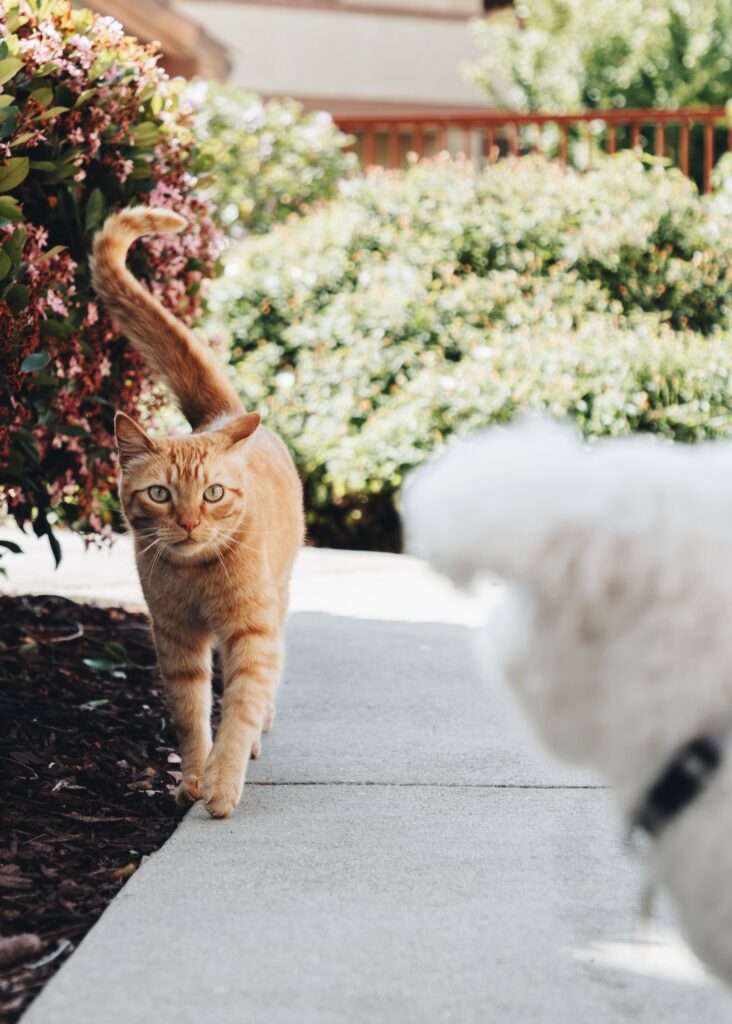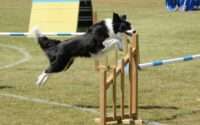From Conflict to Harmony: How to Stop Dog Aggression Towards Cats
Welcome to our comprehensive guide on how to create a harmonious and loving environment for all your furry family members. At BarkLikeMeow, we understand the importance of fostering positive relationships between dogs and cats. If you’re dealing with dog aggression towards cats, worry not! We’re here to help you navigate through this challenging situation with expert advice and proven strategies.
In this guide, we’ll delve into the root causes of dog aggression towards cats, how to identify the signs of aggression, and the crucial role early socialization plays in fostering positive interactions between dogs and cats. We’ll provide you with valuable insights and practical tips to create a safe and supportive environment for your pets.
Let’s embark on this journey together, learning and growing alongside your pets, to achieve a harmonious and loving household!
Identifying the Root Causes of Dog Aggression Towards Cats

Understanding the reasons behind your dog’s aggression towards cats is the first step towards finding effective solutions. Every pet is unique, and there might be various triggers contributing to the aggression. Let’s explore some common root causes:
- Pre-existing experiences and socialization: Dogs may exhibit aggressive behavior towards cats if they haven’t been adequately socialized with them during their formative months. Early exposure and positive experiences are crucial in shaping their attitudes towards feline friends.
- Territorial instincts and resource guarding: Dogs are naturally territorial creatures, and they may view cats as intruders encroaching on their space. Additionally, dogs may become aggressive if they feel the need to protect their food, toys, or sleeping areas.
- Fear and anxiety triggers: Dogs experiencing fear or anxiety may resort to aggression as a coping mechanism. Cats can unknowingly trigger these emotions in dogs, leading to hostile interactions.
- Breed tendencies and individual personalities: Some dog breeds are more predisposed to be aggressive towards cats due to their hunting instincts. Additionally, individual personalities and past experiences can also influence a dog’s behavior.
- Medical conditions and pain-related aggression: Dogs may act aggressively towards cats if they’re experiencing pain or discomfort due to medical conditions. It’s crucial to rule out any health issues that could be contributing to the aggression.
By understanding these root causes, you can begin addressing the underlying factors influencing your dog’s behavior towards cats. Remember, each pet is unique, and patience is key when working towards a peaceful coexistence.
Recognizing the Signs of Aggression in Dogs
Recognizing the signs of aggression in dogs is essential in creating a safe environment for all your pets. Dogs often communicate their feelings through body language and vocalizations. Let’s explore some common signs of aggression:
- Body language cues: Watch for stiff body postures, raised hackles, and intense staring. These may indicate that your dog is feeling threatened or defensive.
- Vocalizations and growling: Dogs may growl, bark aggressively, or snarl when they feel uneasy or threatened. These vocalizations are their way of expressing discomfort or warning others to keep their distance.
- Raised hackles and aggressive postures: When a dog’s hackles (the fur along their back) are raised, it signifies arousal and heightened emotions. Aggressive postures, such as leaning forward or displaying a stiff body, can also indicate potential aggression.
- Aggression triggers and patterns: Observe if specific situations or stimuli consistently trigger aggression in your dog. Recognizing patterns can help you avoid these triggers or implement appropriate training techniques.
Being vigilant about these signs will allow you to intervene early and prevent any aggressive behavior from escalating. If you notice any concerning behaviors, it’s essential to consult a professional dog trainer or behaviorist for personalized guidance.
The Importance of Early Socialization
The significance of early socialization in shaping your dog’s behavior towards cats and other pets cannot be overstated. During the critical puppy phase, exposing your dog to various positive experiences with cats will lay the foundation for future interactions. Here’s how you can ensure successful early socialization:
- Introducing dogs to cats during the puppy phase: If you have a puppy, introduce them to well-behaved, calm cats in a controlled environment. Positive associations during this period are essential for building positive relationships.
- Gradual exposure and supervised interactions: Allow your puppy to observe and interact with cats from a distance initially. As they become more comfortable, gradually increase the proximity and supervise all interactions closely.
- Positive reinforcement for calm behavior: Reward your puppy with treats, praise, and affection when they display calm and friendly behavior around cats. Positive reinforcement encourages positive associations.
Remember, each puppy is different, and some may take longer to adapt to cats. Be patient, and never force interactions. Early socialization should always be a positive and stress-free experience for both your puppy and the cats involved.
Creating a Safe Environment for Cats and Dogs
Understanding the importance of providing a safe and secure environment for both your cats and dogs is crucial. A harmonious living space plays a significant role in preventing aggressive incidents and promoting peaceful coexistence. Here are some tips to create a safe environment:
- Designating pet-specific areas in the house: Create separate areas for your cats and dogs, equipped with their food, water, and bedding. This gives each pet a space they can call their own, reducing potential conflicts.
- Utilizing baby gates and barriers: Install baby gates to restrict access to certain areas of the house. This allows cats to move freely without feeling cornered or threatened by your dog’s presence.
- Providing escape routes for cats: Cats feel more secure when they can escape to higher ground. Install cat shelves, perches, or cat trees to give your feline friends elevated spots where they can observe from a safe distance.
- Cat-friendly elevated spaces: Ensure your cats have easy access to elevated spaces away from your dog’s reach. This helps them feel less vulnerable and gives them the option to retreat when needed.
Remember to supervise interactions between your cats and dogs in the early stages of their cohabitation. A safe environment sets the stage for positive interactions and helps build a trusting relationship between your pets.
Training Techniques to Minimize Aggression
Effective training plays a crucial role in minimizing dog aggression towards cats. Positive reinforcement training methods foster a loving and cooperative bond between your pets. Here are some training techniques to help manage aggression:
- Basic obedience commands: Teach your dog basic commands like “sit,” “stay,” and “leave it.” These commands provide a foundation for managing their behavior around cats and redirecting their focus when needed.
- Counter-conditioning and desensitization: Gradually expose your dog to cats in controlled settings while rewarding calm behavior. Over time, your dog will associate cats with positive experiences, reducing the likelihood of aggressive reactions.
- Clicker training and positive reinforcement: Clicker training can be an effective way to reinforce positive behavior. Use the clicker to mark desired behaviors and reward your dog with treats or praise.
- Using treats and rewards strategically: Use high-value treats to reward your dog when they remain calm and composed around cats. Positive reinforcement helps reinforce desirable behavior and strengthens the bond between your pets.
Consistency is key when implementing training techniques. Regular training sessions and patience will lead to significant progress over time. Always prioritize the safety of both your cats and dogs during training, and avoid any punishment-based methods.
Seeking Professional Help: When to Consult a Trainer or Behaviorist
Dealing with dog aggression towards cats can be challenging, and sometimes, professional guidance is the best way forward. Recognizing when to seek help from a qualified dog trainer or behaviorist is crucial in ensuring the safety and well-being of all your pets. Here are some signs that indicate it’s time to consult a professional:
- Signs of escalating aggression: If your dog’s aggressive behavior towards cats is becoming more frequent or intense, seeking professional help is essential. A trainer or behaviorist can assess the situation and provide tailored solutions.
- Lack of progress with training: If your current training techniques are not yielding the desired results, a professional can offer fresh insights and alternative approaches to address the aggression effectively.
- Safety concerns: If your dog’s aggression poses a threat to the safety of your cats or other pets, it’s crucial to consult a professional immediately. They can help implement measures to keep all pets safe during the training process.
- Medical conditions ruled out: If medical issues have been ruled out as the cause of aggression, a trainer or behaviorist can focus on behavior modification and training to address the issue.
Remember, seeking professional help does not imply failure as a pet owner. Instead, it shows your commitment to providing the best care for your pets. A qualified trainer or behaviorist will work with you and your pets to develop a personalized training plan that suits their unique needs.
Managing Interactions Between Dogs and Cats
Managing interactions between your dogs and cats is a crucial step in fostering positive relationships and preventing aggressive incidents. Gradual and controlled introductions ensure a smooth cohabitation process. Here are some tips for managing interactions:
- Supervised introductions and controlled settings: Always supervise the initial interactions between your pets. Keep your dog on a leash and allow your cat to explore freely. Reward calm and non-aggressive behavior from both pets.
- Avoiding situations that trigger aggression: Identify specific triggers that lead to aggressive reactions in your dog. Minimize exposure to these triggers during the early stages of their interaction.
- Gradual integration for successful cohabitation: Gradually increase the duration and frequency of supervised interactions as your pets become more comfortable with each other. Be patient, as it may take time for them to adjust to each other’s presence.
- Separate feeding areas: To avoid potential resource guarding, feed your pets in separate areas. This prevents any conflicts over food and ensures a stress-free mealtime for everyone.
- Positive reinforcement during interactions: Use treats and praise to reward positive behavior during interactions. Encourage gentle play and discourage rough behavior to create a harmonious atmosphere.
Remember, each pet’s progress will vary, and it’s crucial to respect their individual pace. Some pets may form a close bond quickly, while others may take longer to adjust. Stay patient, and always prioritize their safety and well-being during interactions.
Addressing Aggression Through Behavioral Modification
Addressing dog aggression towards cats requires a thoughtful and systematic approach. Behavioral modification techniques that focus on positive reinforcement and compassionate training are crucial. Here are effective strategies to address aggression:
- Identifying specific triggers and stimuli: Carefully observe your dog’s behavior to pinpoint specific triggers that lead to aggressive reactions. Understanding these triggers will help you tailor your training plan accordingly.
- Implementing consistent training methods: Consistency is key in behavioral modification. Stick to your chosen training techniques and ensure all family members are on the same page when it comes to interacting with your pets.
- Tracking progress and adjusting techniques: Keep a record of your dog’s responses to training sessions and interactions with cats. Use this information to adjust your training techniques and make improvements based on their progress.
- Avoiding punishment-based methods: Avoid using punishment or harsh training techniques, as they can lead to fear and further exacerbate aggression. Focus on positive reinforcement to encourage desired behavior.
- Seeking professional guidance when needed: If you encounter challenges in modifying your dog’s aggressive behavior, don’t hesitate to seek guidance from a professional dog trainer or behaviorist. Their expertise and insights can make a significant difference.
Remember, addressing aggression takes time and patience. It’s essential to celebrate small victories and stay committed to the process. With the right approach, you can help your pets build trust and form a loving bond with one another.
Preventive Measures for a Peaceful Coexistence
Taking preventive measures is crucial in fostering a peaceful coexistence between dogs and cats. By proactively creating a harmonious environment, you can reduce the likelihood of conflicts and aggression. Here are some preventive measures:
- Regular exercise and mental stimulation for dogs: Providing your dog with sufficient physical exercise and mental stimulation can help reduce stress and anxiety, reducing the risk of aggressive behaviors.
- Providing individual attention and enrichment for pets: Ensure that each pet receives adequate individual attention, affection, and playtime. This helps prevent jealousy and promotes a sense of security in your pets.
- Calming aids and natural remedies: Consider using calming aids, such as pheromone diffusers or anxiety wraps, to help ease stress and promote a relaxed atmosphere for your pets.
- Safe and supervised playtime: Allow your pets to play together in a safe and supervised environment. This promotes positive interactions and helps them bond in a controlled setting.
- Maintaining a structured routine: Establishing a consistent daily routine for your pets can help reduce uncertainty and anxiety, contributing to a more stable and harmonious household.
By implementing these preventive measures, you’ll create a loving and tranquil environment where your pets can thrive together. Always remember that each pet is unique, and adjustments may be necessary based on their personalities and needs.
Conclusion
Congratulations on completing our comprehensive guide on how to stop dog aggression towards cats! At BarkLikeMeow, we’re dedicated to supporting you on your pet parenting journey. Remember that fostering a harmonious environment for dogs and cats is a rewarding and fulfilling experience.
Throughout this guide, we’ve explored the root causes of aggression, recognized the signs of aggression, and learned effective training techniques to promote positive interactions. We’ve emphasized the importance of early socialization, creating a safe environment, and seeking professional help when needed.
While rehoming should always be a last resort, it is essential to prioritize the safety and well-being of all pets involved. Should the situation become unmanageable despite your best efforts, considering rehoming with careful consideration becomes an option.
Remember, every pet journey is unique, and there is no one-size-fits-all solution. Embrace the progress your pets make, no matter how small, and cherish the positive moments they share.
We hope this guide has provided you with valuable insights and practical strategies to create lasting harmony between your dogs and cats. Continue to be patient, compassionate, and understanding as you navigate the path to a harmonious household.
Frequently Asked Questions
Q: Is it possible to stop dog aggression towards cats?
A: Absolutely! With the right training techniques, patience, and consistency, you can significantly reduce and even eliminate dog aggression towards cats.
Q: Why does my dog show aggression towards cats?
A: Aggression can stem from various factors, including territorial instincts, lack of socialization, fear, or past negative experiences. Identifying the root cause is essential for effective intervention.
Q: Can I train my dog to get along with cats if they’re already aggressive?
A: Yes, training can help modify your dog’s behavior and improve their relationship with cats. It might take time, but with proper techniques, even dogs with a history of aggression can learn to coexist peacefully.
Q: How should I introduce my dog to my cat to minimize aggression?
A: Introductions should be gradual and controlled. Use positive reinforcement and keep both pets on a leash during initial interactions. Allow them to become familiar with each other’s scent and presence over time.
Q: Are there specific training methods I should use to stop aggression?
A: Positive reinforcement techniques, such as rewarding calm behavior and redirecting focus, are effective in stopping aggression. Punishment-based methods can worsen aggression, so it’s best to avoid them.
Q: When should I seek professional help for dog aggression towards cats?
A: If your dog’s aggression is severe, escalates over time, or if you’re struggling to make progress with training, it’s recommended to consult a professional dog trainer or behaviorist for tailored guidance.
Q: Can cats contribute to the aggression issue?
A: Cats can play a role in the dynamics, such as triggering fear or stress in dogs. It’s essential to consider both pets’ behaviors and interactions to address aggression effectively.
Q: How long does it take to see improvements in my dog’s behavior?
A: The timeline varies based on factors such as the dog’s temperament, the severity of aggression, and your consistency in training. Some dogs may show progress within weeks, while others might take longer.
Q: Are there preventive measures to ensure long-term harmony between my pets?
A: Yes, maintaining a structured routine, providing mental and physical stimulation, and offering individual attention to each pet can contribute to long-term harmony between dogs and cats.
Q: What if training doesn’t work? Should I consider rehoming?
A: If you’ve exhausted various training methods, and the aggression persists, rehoming should be considered as a last resort. Prioritize the safety and well-being of all pets involved in making such a decision.




